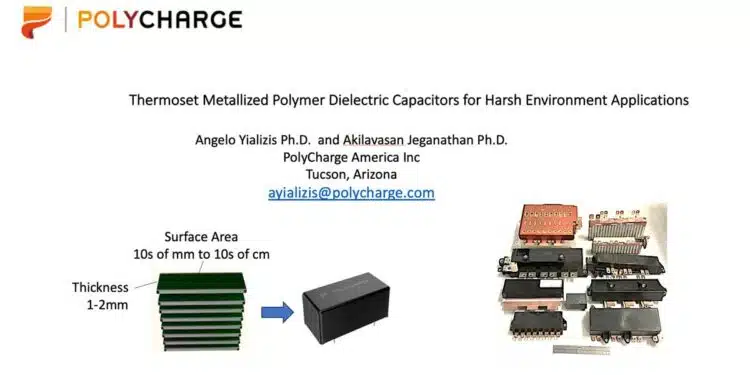The paper “Thermoset Polymer Dielectric Capacitors for Harsh Environment Applications ” was presented by Angelo Yializis, PolyCharge America Inc. Tucson, AZ, USA at the 5th PCNS Passive Components Networking Symposium 9-12th September 2025, Seville, Spain as paper No. 1.1.
Introduction
The article discusses the development and performance of NanoLam™ thermoset polymer dielectric film capacitors for applications in extreme environments.
Electronics designed for harsh industrial, aerospace, automotive, military, and space conditions must endure extreme temperatures, high electrical stress, mechanical shock, and ionizing radiation without performance degradation. Conventional capacitor technologies—such as ceramic multilayer capacitors, electrolytic capacitors, and polymer film capacitors—face limitations that restrict their use in environments requiring both high energy density and reliability under multiple stressors.
NanoLam™ capacitors address these challenges by employing a solid-state, nanolaminate dielectric structure with highly cross-linked thermoset polymers and nanometer-thick aluminum electrodes, enabling operation from -196°C to +160°C with excellent dielectric stability, self-healing properties, and radiation resistance.
Key Points
- NanoLam™ capacitors are designed for operation between -196°C and +160°C, maintaining high energy density and reliability.
- Submicron cross-linked thermoset polymer dielectrics and nanometer-thick aluminum electrodes provide superior dielectric stability.
- Capacitors exhibit self-healing behavior without requiring air gaps, suitable for vacuum and cryogenic conditions.
- High resistance to radiation-induced degradation makes them ideal in aerospace, defense, and nuclear applications.
- Moisture sensitivity at high temperatures and encapsulation challenges remain key considerations for long-term performance.
Extended Summary
The article begins by emphasizing the critical need for capacitors that can reliably operate under extreme environmental conditions, including high and low temperatures, strong mechanical vibrations, and ionizing radiation exposure. Traditional capacitor technologies—ceramic multilayers, electrolytics, and polymer films like polypropylene and PTFE—suffer from either limited energy density, poor radiation resilience, or thermal instability.
NanoLam™ capacitors were introduced to fill this gap, using a nanolaminate structure composed of thousands of submicron polymer dielectric layers and nanometer-scale aluminum electrodes. The dielectric is a beta-radiation-cured thermoset polymer with a glass transition temperature of 200°C, ensuring dimensional stability, low thermal expansion, and enhanced self-healing. This structure mimics multilayer ceramics but offers the mechanical and electrical benefits of a solid-state polymer system.
The article details the capacitors’ parametric stability under various conditions. Voltage and temperature effects on dielectric breakdown and leakage current were analyzed, with experimental results showing that self-healing events occur at predictable overvoltages, and leakage current behavior follows the Poole-Frenkel conduction model. Submicron dielectrics exhibited higher breakdown strength and temperature-dependent conduction, confirming their suitability for high-voltage operation.
Performance in cryogenic conditions was also evaluated. At -196°C, conventional polymer films become brittle due to glass transition effects, but NanoLam™ dielectrics remain well below their Tg, preventing fracture and minimizing thermal contraction mismatch. Their self-healing mechanism, independent of air gaps, functions effectively in vacuum or liquid nitrogen environments. Extended testing under liquid nitrogen immersion demonstrated stable capacitance, ESR, and dissipation factor over 100 hours.
High-temperature performance is equally critical. NanoLam™ capacitors withstand ambient temperatures up to 160°C, maintaining parametric stability when appropriately derated to minimize aluminum electrode corrosion and ESR growth. Tests show that these capacitors outperform larger polypropylene alternatives in high-ripple current scenarios by resisting thermal runaway, though encapsulation remains a limiting factor beyond 160°C due to epoxy Tg and moisture ingress.
Resistance to ionizing radiation is achieved through the highly cross-linked acrylate/methacrylate dielectric network. This structure resists chain scission, charge trapping, and oxidative degradation, while maintaining dielectric integrity and adhesion at nano-interfaces. Independent evaluations, including work by Sandia National Laboratories, validated their suitability for high-radiation, shock-tolerant applications in nuclear and aerospace sectors.
Conclusion
NanoLam™ thermoset polymer dielectric capacitors represent a significant technological advancement for extreme-condition electronics. Their combination of wide temperature tolerance, self-healing capability, high energy density, and radiation resistance addresses the shortcomings of traditional capacitor technologies. Remaining challenges include improving encapsulation methods to manage moisture ingress and mechanical stress in cryogenic and ultra-high-temperature scenarios. With continued development, these capacitors are poised to enable reliable, compact, and high-performance energy storage solutions for mission-critical defense, aerospace, automotive, and space applications.






























